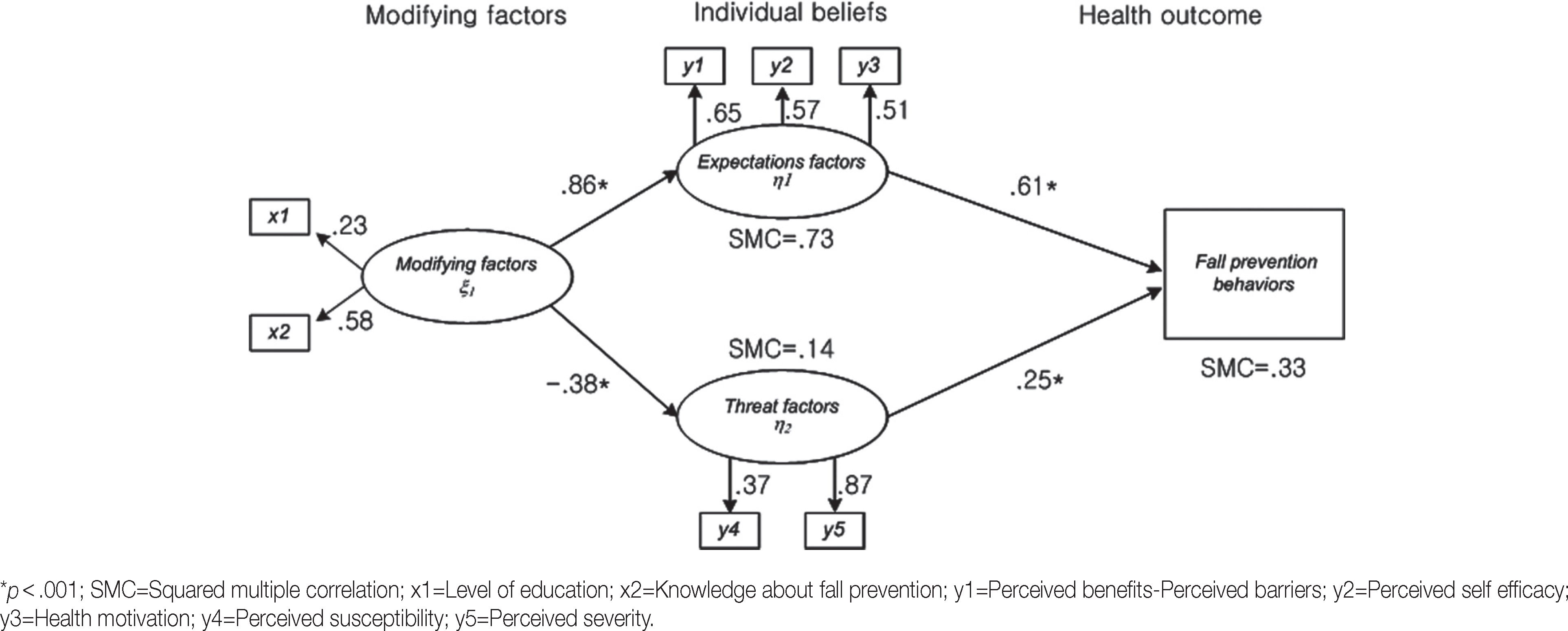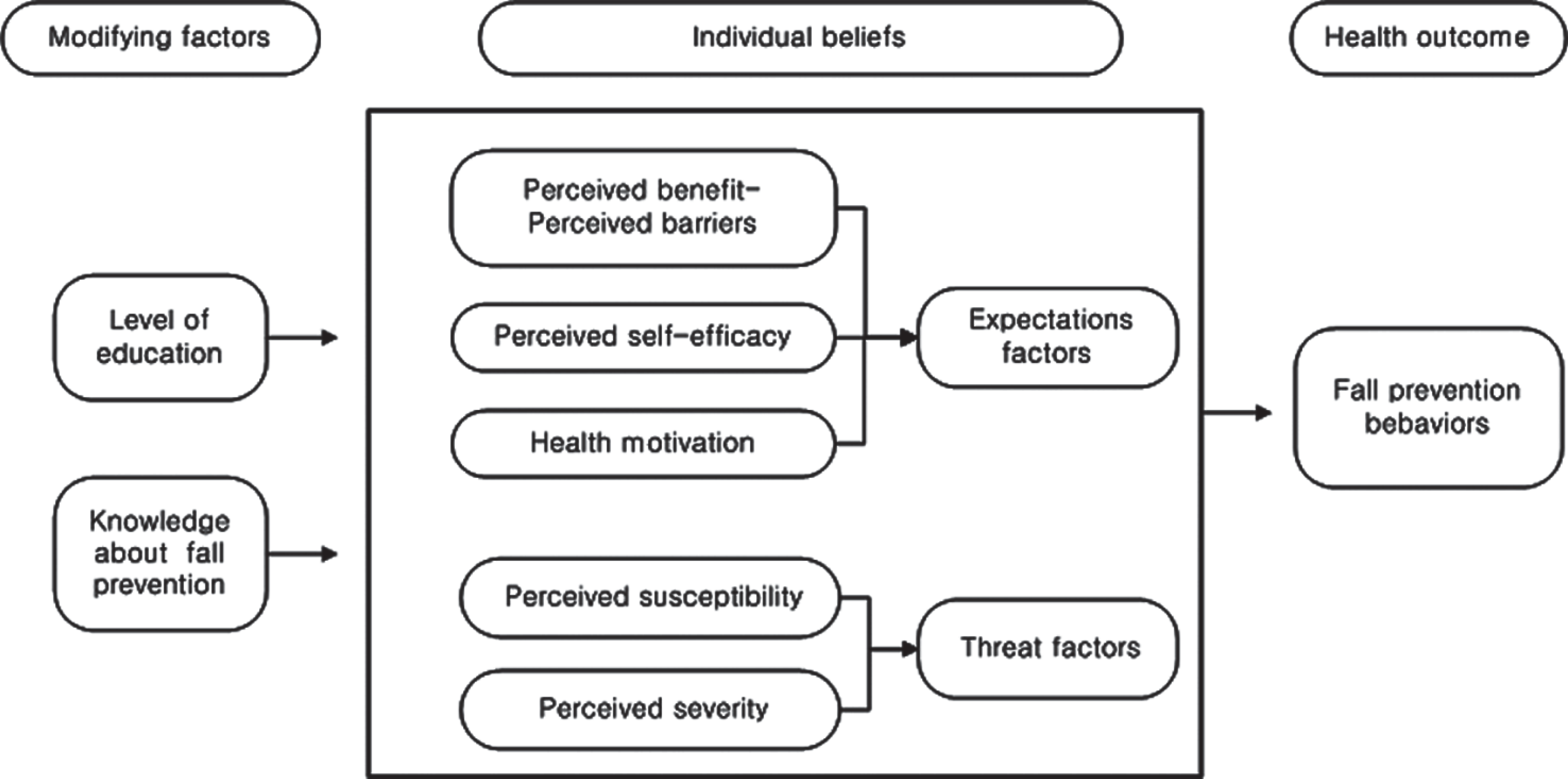Abstract
Purpose
This study was done to propose and test a predictive model that would explain and predict fall prevention behaviors in postmenopausal women. The health belief model was the theoretical basis to aid development of a nursing intervention fall prevention program.
Methods
Data for 421 postmenopausal women were selected from an original data set using a survey design. The structural equation model was tested for 3 constructs: modifying factors, expectation factors, and threat factors. Expectation factors were measured as relative perceived benefit (perceived benefit minus perceived barrier), self-efficacy, and health motivation; threat factors, as perceived susceptibility (fear of falling) and perceived severity (avoiding activity for fear of falling); and modifying factors: level of education and knowledge about fall prevention. Data were analyzed using SPSS Windows and AMOS program.
Results
Mean age was 55.7 years (range 45-64), and 19.7% had experienced a fall within the past year. Fall prevention behaviors were explained by expectation and threat factors indicating significant direct effects. Mediating effect of health beliefs was significant in the relationship between modifying factors and fall prevention behaviors. The proposed model explained 33% of the variance.
Go to : 
References
1. International Osteoporosis Foundation. Osteoporosis & musculoskeletal disorders [Internet]. Nyon, CH: Author;2011. [cited 2012 January 10]. Available from:. http://www.iofbonehealth.org/osteoporosis-musculoskeletal-disorders.
2. Ministry of Health & Welfare, Korean Centers for Disease Control & Prevention. Korea health statistics 2008: Korea national health and nutrition examination survey. Cheongju: Korea Centers for Disease Control and Prevention;2008.
3. Ahn S, Kim Y, Chun N, Lee SH. Incidence of osteoporosis and falls and predictors of fracture risk in postmenopausal women. Korean Journal of Women Health Nursing. 2012; 18(4):237–247. http://dx.doi.org/10.4069/kjwhn.2012.18.4.237.

4. Brenneman SK, Barrett-Connor E, Sajjan S, Markson LE, Siris ES. Impact of recent fracture on health-related quality of life in postmenopausal women. Journal of Bone and Mineral Research. 2006; 21(6):809–816. http://dx.doi.org/10.1359/jbmr.060301.

5. Hill K, Schwarz J. Assessment and management of falls in older people. Internal Medicine Journal. 2004; 34(9-10):557–564. http://dx.doi.org/10.1111/j.1445-5994.2004.00668.x.

6. Rubenstein LZ, Josephson KR. Falls and their prevention in elderly people: What does the evidence show? The Medical Clinics of North America. 2006; 90(5):807–824. http://dx.doi.org/10.1016/j.mcna.2006.05.013.

7. Gillespie LD, Robertson MC, Gillespie WJ, Sherrington C, Gates S, Clemson LM, et al. Interventions for preventing falls in older people living in the community. The Cochrane Database of Systematic Reviews. 2012; 9:CD007146. http://dx.doi.org/10.1002/14651858.CD007146.pub3.

8. Moon ES, Lee ES. The relationship between knowledge, health beliefs, and prevention behaviors of osteoporotic fracture in patients receiving osteoporosis treatment. Korean Journal of Women Health Nursing. 2010; 16(2):147–156. http://dx.doi.org/10.4069/kjwhn.2010.16.2.147.

9. Doheny MO, Sedlak CA, Estok PJ, Zeller R. Osteoporosis knowledge, health beliefs, and DXA T-scores in men and women 50 years of age and older. Orthopaedic Nursing. 2007; 26(4):243–250. http://dx.doi.org/10.1097/01.NOR.0000284654.68215.de.

10. Sedlak CA, Doheny MO, Estok PJ, Zeller RA, Winchell J. DXA, health beliefs, and osteoporosis prevention behaviors. Journal of Aging and Health. 2007; 19(5):742–756. http://dx.doi.org/10.1177/0898264307304303.

11. Kwon MS. Relations among knowledge, fear and efficacy of fall in the community dwelling elderly. Journal of Korean Academy of Community Health Nursing. 2010; 21(2):139–147. http://dx.doi.org/10.12799/jkachn.2010.21.2.139.

12. Jung D. A prediction model of fear of falling in older adults living in a continuing-care retirement community (CCRC) in United States. Journal of the Korean Gerontological Society. 2009; 29(1):243–258.
13. Chang CM, Kang HS. Physical function and psychological status in the elderly those who experienced a fall or not. The Korean Journal of Rehabilitation Nursing. 2004; 7(1):48–57.
14. Rosenstock IM, Strecher VJ, Becker MH. Social learning theory and the health belief model. Health Education Quarterly. 1988; 15(2):175–183.

15. Champion VL, Skinner CS. The health belief model. Glanz K, Rimer BK, Viswanath K, editors. Health behavior and health education: Theory, research, and practice. 4th ed. San Francisco, CA: Jossey-Bass;2008. p. 45–65.
16. Hur JY, Kim HJ. Relationship of risk factors, knowledge and attitude to falls in elderly inpatients. Journal of the Korean Gerontological Nursing. 2009; 11(1):38–50.
17. Kempen GI, van Haastregt JC, McKee KJ, Delbaere K, Zijlstra GA. Socio-demographic, health-related and psychosocial correlates of fear of falling and avoidance of activity in community-living older persons who avoid activity due to fear of falling. BMC Public Health. 2009; 9:170. http://dx.doi.org/10.1186/1471-2458-9-170.

18. Kim GS. Analysis structural equation modeling. Seoul: Hannarae Publishing Co.;2010.
19. Currie L. Fall and injury prevention. Hughes RG, editor. Patient safety and quality: An evidence-based handbook for nurses. Rockville, MD: Agency for Healthcare Research and Quality (US);2008.
20. Hur JH, Lim SK, Lee DH. Development of the Korean Falls Efficacy Scale (FES-K) for the elderly. The Korean Journal of Physical Education. 2010; 49(3):193–201.
21. Ahn S. Osteoporosis and fall prevention project for postmenopausal women. Paper presented at: 2014 Aging in America Conference. 2014. March 11-15; Manchester Grand Hyatt, San Diego, CA.
22. Kim KK, Horan M, Gendler P, Patel MK. Osteoporosis health belief, self-efficacy, and knowledge tests. Redman BK, editor. Measurement tools in patient education. 2nd ed. New York, NY: Springer Publishing Company;2003. p. 364–375.
23. Lee SH. Prediction model on osteoporosis prevention behavior in middle aged women [dissertation]. Seoul: Korea University;2006.
24. Tideiksaar R. Falls in older people: Prevention and management. 3rd ed. Baltimore, MD: Health Professions Press;2002.
25. Ahn S, Kim H, So H, Song R. Factors influencing fear of falling in post- menopausal women. Korean Journal of Women Health Nursing. 2009; 15(4):344–352. http://dx.doi.org/10.4069/kjwhn.2009.15.4.344.
26. Kim YH. Relations among fall efficacy, perception of fall risk and fall prevention behavior in the frail elderly at home. Journal of the Korea Academia-Industrial Cooperation Society. 2013; 14(7):3383–3389.

27. Hwang SY, Shin SJ. Predictors of fall prevention behaviors in elderly inpatients. Korean Journal of Health Promotion. 2013; 13(2):76–85.
Go to : 
 | Figure 2.Standardized estimates and explained variances in model for fall prevention behaviors. |
Table 1.
Descriptive Statistics and Relationships among Study Variables for Fall Prevention Behaviors (N=421)
Table 2.
Effects of Explanatory Variables on Fall Prevention Behaviors (N=421)




 PDF
PDF ePub
ePub Citation
Citation Print
Print



 XML Download
XML Download